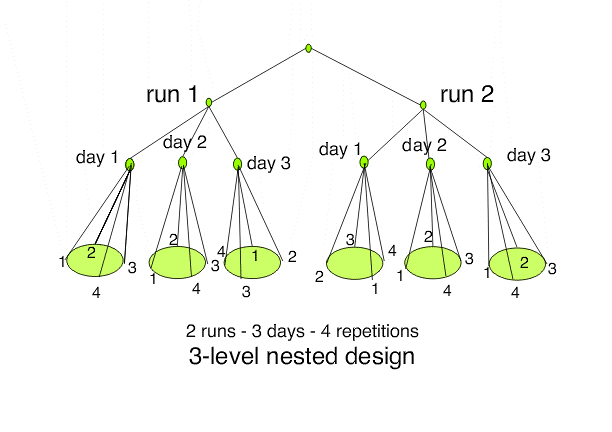

|
2.
Measurement Process Characterization
2.4. Gauge R & R studies 2.4.3. Data collection for time-related sources of variability
|
|||
| Advantages of nested designs | A nested design is recommended for studying the effect of sources of variability that manifest themselves over time. Data collection and analysis are straightforward, and there is no reason to estimate interaction terms when dealing with time-dependent errors. Nested designs can be run at several levels. Three levels are recommended for measurement systems where sources of error are not well understood and have not previously been studied. | ||
| Time intervals in a nested design |
The following levels are based on the characteristics of many
measurement systems and should be adapted to a specific measurement
situation as need be. A typical design is shown below.
|
||
| Definition of number of measurements at each level |
The following symbols are defined for this chapter:
For the design shown above, J = 4; K = 3 and L = 2. The design can be repeated for:
|
| 2-level nested design | The design can be truncated at two levels to estimate repeatability and day-to-day variability if there is no reason to estimate longer-term effects. The analysis remains the same through the first two levels. |
| Advantages | This design has advantages in ease of use and computation. The number of repetitions at each level need not be large because information is being gathered on several check standards. |
| Operator considerations | The measurements should be made with ONE operator. Operator is not usually a consideration with automated systems. However, systems that require decisions regarding line edge or other feature delineations may be operator dependent. If there is reason to believe that results might differ significantly by operator, 'operators' can be substituted for 'runs' in the design. Choose L (L > 2) operators at random from the pool of operators who are capable of making measurements at the same level of precision. (Conduct a small experiment with operators making repeatability measurements, if necessary, to verify comparability of precision among operators.) Then complete the data collection and analysis as outlined. In this case, the level-3 standard deviation estimates operator effect. |
| Caution | Be sure that the design is truly nested; i.e., that each operator reports results for the same set of circumstances, particularly with regard to day of measurement so that each operator measures every day, or every other day, and so forth. |
| Randomize on gauges | Randomize with respect to gauges for each check standard; i.e., choose the first check standard and randomize the gauges; choose the second check standard and randomize gauges; and so forth. |
| Record results in a file |
Record the average and standard deviation
from each group of J repetitions by:
|
| Case Study: Resistivity Gauges |
Results should be recorded along with pertinent environmental
readings and identifications for significant factors. The best way
to record this information is in one file with one line or row (on
a spreadsheet) of information in fixed fields for each check standard
measurement. A list of typical entries follows.
|
